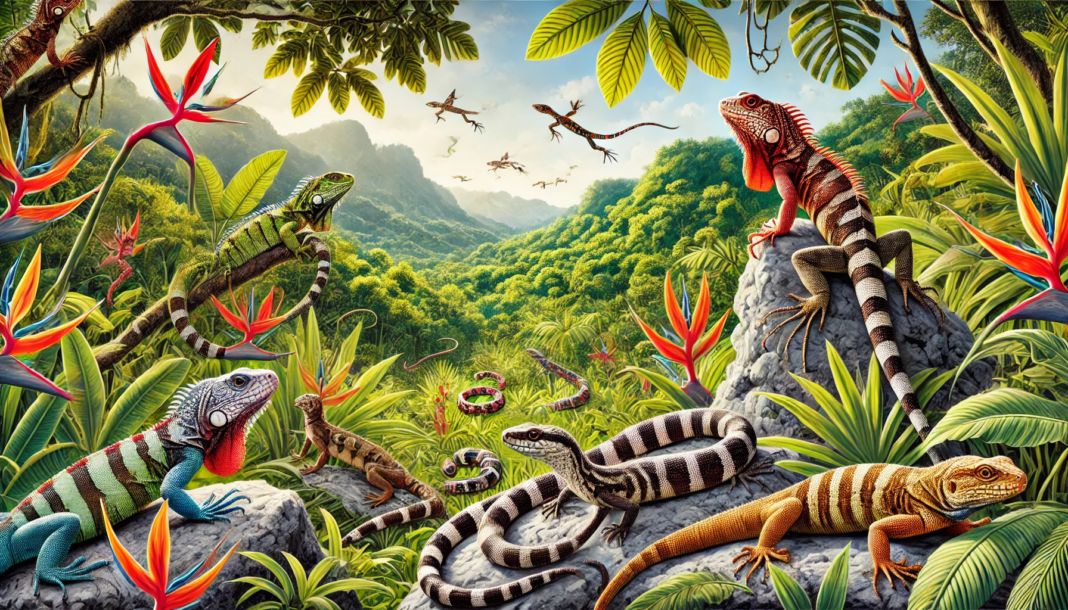The Caribbean is home to a fascinating array of reptiles, from colorful lizards darting through lush forests to stealthy snakes slithering through grasslands.
The region’s diverse ecosystems, including rainforests, dry forests, wetlands, and coral islands, offer ideal habitats for these cold-blooded creatures.
Whether you’re an avid herpetologist or a nature enthusiast, exploring the reptiles of the Caribbean offers a unique glimpse into the region’s biodiversity.
In this guide, we’ll delve into the most notable reptiles found throughout the Caribbean, their habitats, behaviors, and conservation status.
1. Caribbean Lizards: Diversity and Adaptation
Lizards are one of the most widespread reptiles in the Caribbean, with species adapted to various environments, from sandy beaches to dense rainforests. These reptiles play an essential role in controlling insect populations and serving as prey for larger animals.
1.1 Anoles
Perhaps the most well-known and abundant lizards in the Caribbean are anoles, small lizards recognized by their ability to change color, similar to chameleons. The Cuban brown anole (Anolis sagrei) and the green anole (Anolis carolinensis) are among the most common species, found across islands like Cuba, Puerto Rico, and the Bahamas.
- Habitat: Anoles thrive in forests, gardens, and urban areas, often seen clinging to tree trunks or basking on fences.
- Unique Traits: Male anoles have a dewlap, a brightly colored throat fan they display during courtship or territorial disputes.
- Interesting Fact: Anoles can regenerate their tails if they lose them, a common escape tactic when predators are near.
1.2 Iguanas
Iguanas are some of the most iconic reptiles in the Caribbean, especially the green iguana (Iguana iguana) and the endangered Caribbean rock iguana species. While green iguanas are often seen lounging in treetops near water, rock iguanas are ground-dwellers, inhabiting dry, rocky landscapes.
- Cuban Rock Iguana (Cyclura nubila): Found in Cuba and the surrounding islands, this iguana species is among the largest in the Caribbean, reaching lengths of up to 5 feet.
- Jamaican Iguana (Cyclura collei): Once thought to be extinct, this critically endangered iguana was rediscovered in 1990 and is now the focus of intense conservation efforts.
- Interesting Fact: Iguanas are primarily herbivores, feeding on leaves, fruits, and flowers. Their diet helps with seed dispersal in their environments.
1.3 Geckos
Geckos are another group of small, nocturnal lizards common throughout the Caribbean. With their sticky toe pads, geckos can easily scale vertical surfaces, from trees to house walls. The house gecko (Hemidactylus frenatus) is commonly seen around homes, where it hunts insects attracted to light.
- Unique Trait: Geckos have specialized toe pads covered in microscopic hairs that allow them to cling to almost any surface, even glass.
- Interesting Fact: Geckos are known for their chirping and clicking vocalizations, which they use to communicate, especially during mating season.
2. Snakes of the Caribbean: Mystical and Misunderstood
Caribbean snakes often elicit both fascination and fear, but they play an important role in maintaining the ecological balance by controlling populations of small mammals, birds, and insects. Most snakes in the Caribbean are non-venomous, and the region is known for its diversity of harmless species.
2.1 Boas
Boas are among the largest and most impressive snakes in the Caribbean, and they are non-venomous. These powerful constrictors kill their prey by coiling around them and squeezing until they suffocate. Two notable boas found in the region are:
- Cuban Boa (Chilabothrus angulifer): The largest snake in the Caribbean, reaching lengths of over 12 feet, the Cuban boa is often found in forests and caves, where it preys on birds, bats, and rodents.
- Bahama Boa (Chilabothrus striatus): This medium-sized boa is commonly found in the Bahamas and feeds primarily on small mammals, birds, and reptiles. It is known for its distinctive banded or striped pattern.
- Interesting Fact: Boas are excellent swimmers and are often found near water sources.
2.2 Racers
Racers are a group of fast-moving, non-venomous snakes found in various Caribbean islands. These slender snakes primarily feed on lizards, frogs, and small mammals. Some notable species include:
- Jamaican Racer (Alsophis ater): Endemic to Jamaica, this snake was once widespread but is now critically endangered due to habitat loss and predation by introduced species like mongooses.
- Puerto Rican Racer (Borikenophis portoricensis): Commonly found in Puerto Rico, this snake is often seen in forested areas, hunting for lizards and rodents.
2.3 Blind Snakes
One of the most unique snakes found in the Caribbean is the blind snake (Typhlopidae), a small, burrowing species that is often mistaken for a worm due to its size and appearance. These snakes spend most of their lives underground, feeding on ants, termites, and other small invertebrates.
- Interesting Fact: Blind snakes are completely harmless and play an essential role in pest control by keeping termite populations in check.
3. Marine Reptiles: Sea Turtles and More
The Caribbean’s warm waters are a vital habitat for several species of sea turtles, which come to the region’s beaches to nest. Sea turtles are among the most beloved reptiles in the Caribbean, admired for their grace and importance to marine ecosystems.
3.1 Sea Turtles
- Leatherback Turtle (Dermochelys coriacea): The largest of all sea turtles, leatherbacks are often spotted in the Caribbean. They are known for their migratory patterns, traveling thousands of miles between feeding and nesting grounds. Leatherbacks nest on Caribbean beaches from March to July.
- Hawksbill Turtle (Eretmochelys imbricata): This critically endangered species is commonly found around coral reefs, where it feeds on sponges and invertebrates. Hawksbills nest on Caribbean beaches from April to November.
- Green Turtle (Chelonia mydas): Named for the green color of their fat, these turtles are herbivorous, feeding on seagrass. They nest in the Caribbean from June to October.
- Conservation Efforts: Several Caribbean islands have implemented conservation programs to protect nesting beaches and reduce threats like poaching and plastic pollution.
3.2 American Crocodile
Though less common, the American crocodile (Crocodylus acutus) can be found in brackish waters and coastal areas of the Caribbean, particularly in Cuba, Hispaniola, and parts of Jamaica. These crocodiles prefer mangrove swamps and estuaries, where they feed on fish, birds, and small mammals.
- Interesting Fact: Despite their fearsome reputation, American crocodiles are generally shy and avoid human contact unless threatened.
4. Conservation and Threats to Caribbean Reptiles
Many of the Caribbean’s reptiles face threats from habitat loss, climate change, invasive species, and poaching. For example, the introduction of mongooses to control snake populations has had devastating effects on native species, especially on islands like Jamaica and Puerto Rico. Additionally, coastal development threatens critical nesting sites for sea turtles, while the illegal pet trade puts further pressure on vulnerable species like iguanas and boas.
Conservation Initiatives:
- Wildlife Reserves and National Parks: Protected areas like El Yunque National Forest in Puerto Rico and the Blue and John Crow Mountains National Park in Jamaica serve as vital refuges for reptile species.
- Breeding and Reintroduction Programs: Initiatives to breed and reintroduce critically endangered reptiles, like the Jamaican Iguana, are key to saving these species from extinction.
- Marine Turtle Conservation: Many Caribbean islands participate in global efforts to protect sea turtles by monitoring nesting sites, rescuing injured turtles, and educating the public.
Conclusion
The Caribbean is home to an extraordinary variety of reptiles, each contributing to the region’s rich biodiversity. From colorful lizards to stealthy snakes and ancient sea turtles, these reptiles play critical roles in maintaining healthy ecosystems. Whether you’re exploring the forests of Jamaica or snorkeling off the coast of Barbados, there’s no shortage of opportunities to witness these fascinating creatures in their natural habitats.
FAQ
What are the most common reptiles found in the Caribbean?
Common reptiles in the Caribbean include anoles, iguanas, geckos, boas, racers, and sea turtles.
Are there venomous snakes in the Caribbean?
Venomous snakes are rare in the Caribbean. The majority of snakes in the region, such as boas and racers, are non-venomous and pose no threat to humans.
When is the best time to see sea turtles in the Caribbean?
The best time to see nesting sea turtles is between March and October, depending on the species and island.
How can I help with reptile conservation in the Caribbean?
You can support reptile conservation by visiting national parks and reserves, participating in eco-friendly tours, and supporting organizations working to protect endangered species and habitats.
Are iguanas endangered in the Caribbean?
Some iguana species, such as the Jamaican Iguana and Caribbean Rock Iguana, are critically endangered due to habitat loss and introduced predators like the mongoose.

